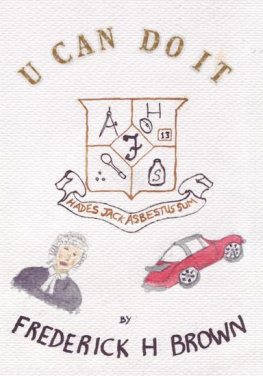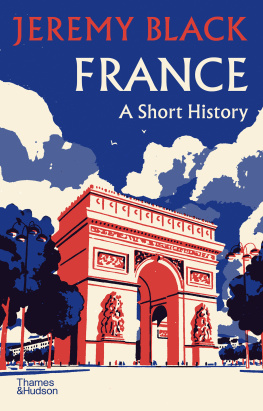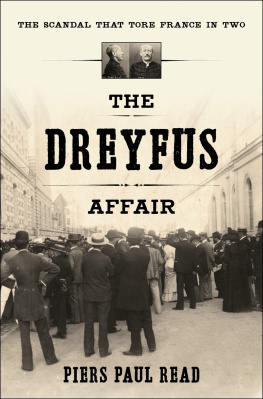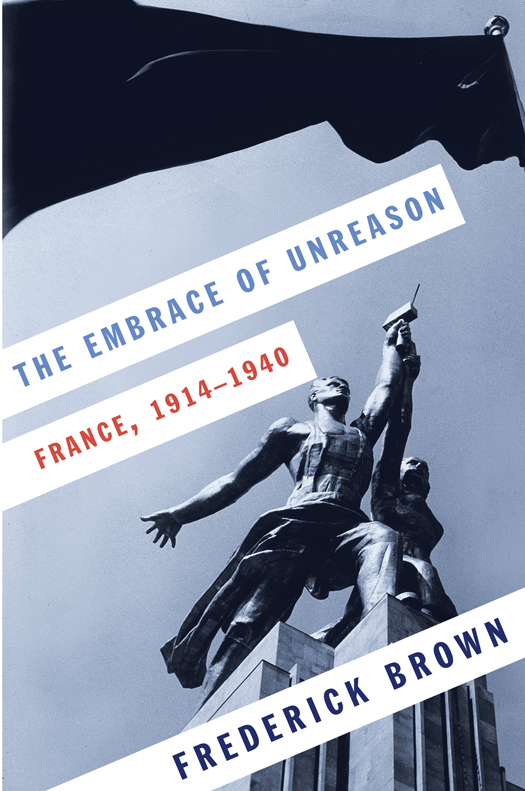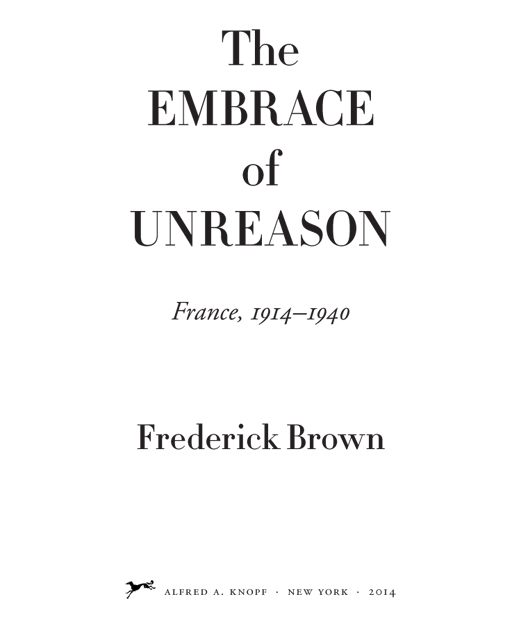THIS IS A BORZOI BOOK
PUBLISHED BY ALFRED A. KNOPF
Copyright 2014 by Frederick Brown
All rights reserved. Published in the United States by Alfred A. Knopf, a division of Random House LLC, New York, and in Canada by Random House of Canada Limited, Toronto, Penguin Random House companies.
www.aaknopf.com
Knopf, Borzoi Books, and the colophon are registered trademarks of Random House LLC.
An earlier version of chapter four was first published as The Battle for Joan in The Hudson Review, Vol. LXV, No. 3 (Autumn 2012).
All images are reprinted courtesy of Getty Images with the exception of images on from a private collection.
Cataloging-in-Publication Data is available from the Library of Congress.
ISBN 978-0-307-59515-7
ISBN 978-0-385-35163-8 (eBook)
Cover image: Soviet pavilion at Worlds Fair, Paris, France, 1937.
Hulton Archive/Getty Images
Cover design by Carol Devine Carson
v3.1
To Ruth Lurie Kozodoy and Paul Dolan
And in memory of my dear friend Joseph Frank
Contents
CHAPTER 1
The Coming of War
CHAPTER 2
The Making of a Xenophobe
CHAPTER 3
The Nightingale of the Carnage
CHAPTER 4
The Battle for Joan
CHAPTER 5
Royalisms Deaf Troubadour
CHAPTER 6
Spy Mania and Postwar Revenge
CHAPTER 7
Scars of the Trenches
CHAPTER 8
The Rapture of the Deep
CHAPTER 9
The Stavisky Affair
CHAPTER 10
The Congress of Writers for the Defense of Culture
CHAPTER 11
Totalitarian Pavilions
CHAPTER 12
The Hero of Verdun
Prologue
Until recent times, the French political imagination was disposed to associate its dogmas and enthusiasms with the symbol of the tree. In 1792, revolutionaries at war with monarchical Europe planted arbres de la libert in towns and villages throughout the country, taking their cue from the American patriots who had rallied for independence at a famous elm near the Boston Common. Among the hundreds that dotted Paris (mostly poplars, which grew quickly and had the further advantage of deriving etymologically from the Latin populus), one was planted within view of the royal palace in a ceremony over which the king himself presided, under duress. It was cut down several years later, not long after Louis XVI had been guillotined, despite the chief judges pronouncement at Louiss trial that the tree of liberty grows only when watered by the blood of tyrants. Otherwise, cutting down a liberty tree under the new dispensation was tantamount to profaning the host under the old regime and punished accordingly. When a villager felled one in the Vaucluse, sixty-three neighbors who concealed his identity paid the forfeit, exemplifying Robespierres notorious oxymoron, the despotism of liberty. They were killed, their houses were burned, and their fields were salted.
As the Revolution understood freedom to be a universal birthright, liberty trees did not require native soil. They grew in land conquered by the Republic beyond the Rhine and, abroad, in the Caribbean colonies, where their proximity to slave markets before the abolition of slavery, in 1794, was noted by one derisive observer.
Far from preserving the original character of trees planted under revolutionary auspices, Napoleon, who came out of the Revolution, allowed them to survive as arbres Napolon while discouraging ceremonies that glorified the advent of liberty. They numbered at least sixty thousand when Louis XVIII mounted the throne of a restored monarchy. Seen thenceforth as culpable mementos of a hiatus in the the Bourbon succession, liberty trees were harvested for firewood or furniture.
With the overthrow of Louis-Philippe in 1848 and the establishment of the Second Republic, maypoles reappeared in plantings that surpassed the exuberance of eighteenth-century celebrations. The plantings had multiplied a hundredfold, wrote a chronicler. They were to be seen at all the markets, squares, quays, gardens, intersections, and even in the courtyards of public institutions, at the Prefecture of Police, at the Opra, etc. Patriotic songs, religious ceremonies, speeches, music, the national guard, acclamations, flowers, ribbons, the discharge of weapons, the curious crowd made for a lively spectacle. As Louis XVI had been pressed into service in the early 1790s, so now Victor Hugo, deputy mayor of the 9th arrondissement, presided over the planting of a poplar on the Place des Vosges, where he resided. Priests were invited to water saplings with their silver aspergillums.
Those thousands of well-watered saplings were given no nourishment once the Second Republic was overthrown by the future Napoleon III, in 1851. They withered during the Second Empire, but their right-wing analogue sprang to life several decades later, after the Franco-Prussian War of 1870 to 1871, not in a material sense but as a trope signifying national and racial authenticity. Of paramount importance was the publication in 1897 of Les Dracins (The Uprooted), a novel that follows seven young Lorrainers torn from their cultural roots and sent into the world as existential waifs by a teacher of philosophy pledged to Kantian universals. Alas, Lorraine undertook a great enterprise, wrote Maurice Barrs, who had made his name not only as a novelist but as a politician militantly championing the would-be dictator General Georges Boulanger. She deported a certain number of her sons from Neufchteau, from Nomeny, from Custines, from Varennes, so that they might rise to a superior ideal. The thought was that by elevating the seven young Lorrainers from their native grounds to France, and even to humanity, they would be brought closer to reason.... Did those who directed this emigration realize that they had charge of souls? Did they perceive the dangerous gravity of their act? They couldnt replant the uprooted in congenial earth. Not knowing whether they wanted to make them citizens of humanity or Frenchmen of France, they evicted them from sturdy, age-old homes and let the denless cubs fend for themselves. From their natural order, humble perhaps but social, they blundered into anarchy, into mortal disorder. The soul, which thrived on necessity rather than freedom and owed its consecration to forebears buried in the soil of ones homeland, could not be transplanted. It was rooted rather than intellectual, organic rather than abstract, collective rather than individual. It was the pith that showed intelligence to be a very small thing on the surface of ourselves. It was to Frenchmen what derelict country churches were in the secular, bourgeois state to la France profonde.
Its virtue lent itself to many of the evils of the twentieth century. In novels, essays, and articles, the prolific Barrs did much to shape opinion during the Dreyfus Affair and the war of 19141918, expounding the view as eloquently as any of his ideological confrres that diasporic Jews with shallow roots were susceptible of treason, glorifying the brotherhood of men in trenches, consecrating the blood they shed on fields shorn of trees, and generally reviling the Enlightenment. These were not his pieties alone. They became the accepted wisdom of the Right and echoed across the decades, from war to war. In the seventeenth century, Blaise Pascal had observed ironically, What is truth on one side of the Pyrenees is error on the other. But in 1940 Marshal Ptain, justifying his pact with Hitler and the invention of a satellite state in the face of de Gaulles exhortations from England to resist, assured his compatriots without a trace of irony that the soil on which he stood like a deeply rooted tree vouched for his authority: The earth does not lie; it will be your refuge.


